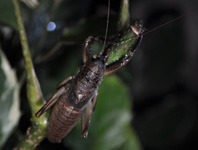Abstract
Nesoecia Scudder, 1893 is a neotropical genus of true katydids (Pseudophyllinae) comprising four species: N. brasiliensis (Bruner, 1915) from Brazil (Bahia), N. cooksonii (Butler, 1877) from Ecuador (Galápagos, Floreana Island), and two species from southern Mexico: N. insignis (Hebard, 1932) from Yucatán (Temax and Chichen-Itza), and N. nigrispina (Stål, 1873) reported also from Yucatán and the State of Tabasco (Teapa). Members of this genus are large and attractive insects, nonetheless, they have been poorly studied since they are not abundant or commonly collected. This paper describes four new species of Nesoecia from the Huasteca Region in northeastern México: N. huichihuayan n. sp., N. potoniya n. sp., N. insolita n. sp., and N. constricta n. sp. Taxa delimitation is based on morphological diagnostic characters and parameters of the acoustic signal. Information on distribution, habitat, and behavior is provided. [urn:lsid:zoobank.org:act:B932F2DC-97F4-4751-A6F7-0869318364FA]
References
Brunner von Wattenwyl, C. (1895) Monographie der Pseudophylliden. Verhandlungen der Kaiserlich-Königlichen Zoologisch-Botanischen Gesellschaft in Wien, 45, 1–282.
Bruner, L. (1913-1915) Notes on Tropical American Tettigonoidea (Locustodea), XVIII, 284-404. Annals of the Carnegie Museum, 9 (3–4), 1–423.
Butler, A.G. (1877) Lepidoptera, Orthoptera, and Hemiptera, X, 86–94. Proceedings of the Scientific Meetings of the Zoological Society of London, 1877, 1–368.
Cigliano, M.M., Braun, H., Eades, D.C. & Otte, D. (2020) Orthoptera Species File Online (OSF). Version 5.0/5.0. http://Orthoptera.SpeciesFile.org (accessed 18 March 2020)
Dutta, R., Tregenza, T. & Balakrishnan, R. (2017) Reproductive isolation in the acoustically divergent groups of tettigoniid, Mecopoda elongata. PLoS ONE, 12 (11), e0188843.
https://doi.org/10.1371/journal.pone.0188843
Hebard, M. (1932) New species and records of Mexican Orthoptera. Transactions of the American Entomological Society, 58 (3), 201–376.
Heller, K.G., Orci, K.M., Grein, G. &Ingrisch, S. (2004) The Isophya species of Central and Western Europe (Orthoptera: Tettigonioidea: Phaneropteridae). Tijdschrift Voor Entomologie, 147, 237–258.
https://doi.org/10.1163/22119434-900000153
Heller, K.G., Hemp, C., Ingrisch, S. & Liu, C. (2015) Acoustic communication in Phaneropterinae (Tettigonioidea)-A global review with some new data. Journal of Orthoptera Research, 24 (1), 7–18.
https://doi.org/10.1665/034.024.0103
Heller, K.G., Ingrisch, S., Liu, C., Shi, F., Hemp, C., Warchałowska-Śliwa, E. & Rentz, D.C.F. (2017) Complex songs and cryptic ethospecies: the case of the Ducetia japonica group (Orthoptera: Tettigonioidea: Phaneropteridae: Phaneropterinae). Zoological Journal of the Linnean Society, 181 (2), 286–307.
https://doi.org/10.1093/zoolinnean/zlw019
Kowalski, K. & Lakes-Harlan, R. (2011) Temporal patterns of intra- and interspecific acoustic signals differ in two closely related species of Acanthoplus (Orthoptera: Tettigoniidae: Hetrodinae). Zoology, 114, 29–35. [PMID: 21236652]
https://doi.org/10.1016/j.zool.2010.09.002
Morris, G.K. (1980) Calling display and mating behaviour of Copiphora rhinoceros Pictet (Orthoptera: Tettigoniidae). Animal Behaviour, 28, 42–51.
https://doi.org/10.1016/ S0003-3472(80)80006-6
Morris, G.K., Mason, A.C., Wall, P. & Belwood, J.J. (1994) High ultrasonic and tremulation signals in Neotropical katydids (Orthoptera: Tettigoniidae). Journal of Zoology, 233, 129–163.
Pérez-Gelabert, D. (2020) Tainacanthus ferox, a remarkable new genus and species of Katydids from the high mountains of Hispaniola (Orthoptera: Tettigoniidae: Pseudophyllinae: Polyancistrini). Novitates Caribaea, 15, 27–41.
Ragge, D.R. & Reynolds, W.J. (1998) The Songs of the Grasshoppers and Crickets of Western Europe. Colchester, Harley Books, 591 pp.
Rehn, J.A.G. (1903) A contribution to the knowledge of the Orthoptera of Mexico and Central America. Transections of the American Entomological Society, 29 (1), 28–34.
Scudder, S.H. (1893–1895) The Orthoptera of the Galapagos Islands, VII, 1–26. Harvard University. Bulletin of the Museum of Comparative Zoology, 25, 1–368.
Stål, C. (1873) Orthoptera nova descripsit. Ӧfversigt Kongl. Vetenskaps-Akademiens Förhandlingar. Tretionde Árgángen, 30 (4), 39–54.
SINA [Singing Insects of North America] (2019) Available from: http://entnemdept.ifas.ufl.edu/walker/Buzz/ (accessed 21 February 2020)
Stumpner, A., Angela, A., Schink, M., Gubert, S. & Hugel, S. (2013) True katydids (Pseudophyllinae) from Guadeloupe: Acoustic signals and functional considerations of song production. Journal of Insect Science, 13, 157. [http://www.insectscience.org/13.157]
Vahed, K., Gilbert, J.D.J., Weissman, D.B. & Barrientos-Lozano, L. (2014) Functional equivalence of grasping Cerci and nuptial food gifts in promoting ejaculate transfer in katydids. Evolution, 68-7, 2052–2065. Available from: https://onlinelibrary.wiley.com/doi/pdf/10.1111/evo.12421 (accessed 17 August 2020)


